Factors Influencing Customer Adoption of Internet Banking in Sri Lanka
VerifiedAdded on 2022/02/14
|20
|7563
|20
Report
AI Summary
This research paper investigates the factors influencing the adoption of internet banking in Sri Lanka, focusing on customer behavior and the challenges banks face in promoting online services. The study, based on an extension of the decomposed theory of planned behavior, examines the impact of attitudes (including innovation characteristics like relative advantage, compatibility, complexity, trialability, and risk), subjective norms, and perceived behavioral control on internet banking adoption. Conducted through an online questionnaire survey in the Colombo and Gampaha districts, the research reveals that attitudinal and perceived behavioral control factors are more significant than social influence in driving adoption. Specifically, relative advantage, compatibility with values, internet skills, trialability, risk perception, self-efficacy, and technology support were found to influence adoption. The study concludes with implications for banks, suggesting the need for pull strategies to encourage internet banking adoption among Sri Lankan customers, where resistance to adopting technology remains a significant issue. The paper also provides a detailed literature review on internet banking, its benefits, and its current status in Sri Lanka, highlighting the gap between awareness and actual usage of online banking services.
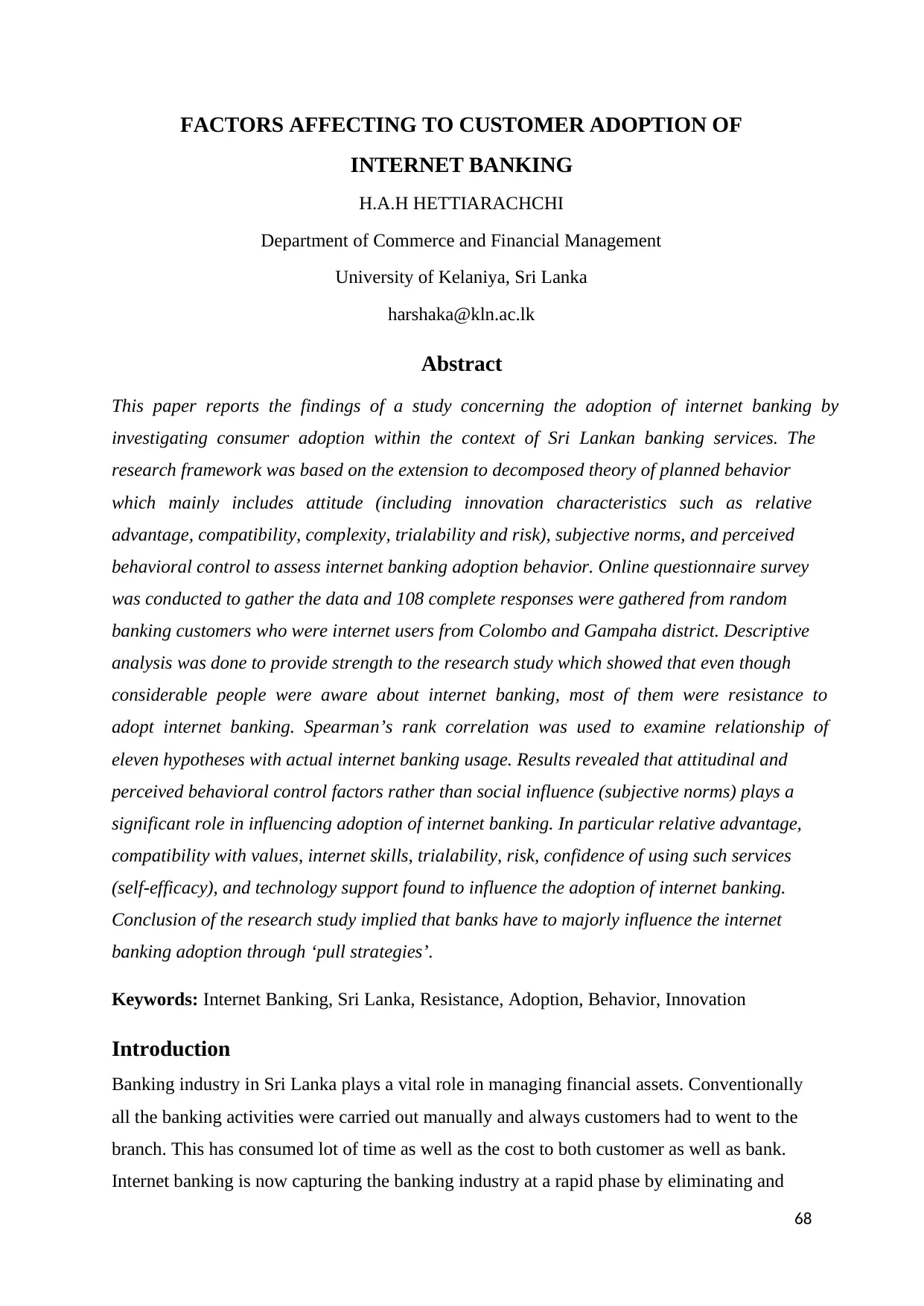
68
FACTORS AFFECTING TO CUSTOMER ADOPTION OF
INTERNET BANKING
H.A.H HETTIARACHCHI
Department of Commerce and Financial Management
University of Kelaniya, Sri Lanka
harshaka@kln.ac.lk
Abstract
This paper reports the findings of a study concerning the adoption of internet banking by
investigating consumer adoption within the context of Sri Lankan banking services. The
research framework was based on the extension to decomposed theory of planned behavior
which mainly includes attitude (including innovation characteristics such as relative
advantage, compatibility, complexity, trialability and risk), subjective norms, and perceived
behavioral control to assess internet banking adoption behavior. Online questionnaire survey
was conducted to gather the data and 108 complete responses were gathered from random
banking customers who were internet users from Colombo and Gampaha district. Descriptive
analysis was done to provide strength to the research study which showed that even though
considerable people were aware about internet banking, most of them were resistance to
adopt internet banking. Spearman’s rank correlation was used to examine relationship of
eleven hypotheses with actual internet banking usage. Results revealed that attitudinal and
perceived behavioral control factors rather than social influence (subjective norms) plays a
significant role in influencing adoption of internet banking. In particular relative advantage,
compatibility with values, internet skills, trialability, risk, confidence of using such services
(self-efficacy), and technology support found to influence the adoption of internet banking.
Conclusion of the research study implied that banks have to majorly influence the internet
banking adoption through ‘pull strategies’.
Keywords: Internet Banking, Sri Lanka, Resistance, Adoption, Behavior, Innovation
Introduction
Banking industry in Sri Lanka plays a vital role in managing financial assets. Conventionally
all the banking activities were carried out manually and always customers had to went to the
branch. This has consumed lot of time as well as the cost to both customer as well as bank.
Internet banking is now capturing the banking industry at a rapid phase by eliminating and
FACTORS AFFECTING TO CUSTOMER ADOPTION OF
INTERNET BANKING
H.A.H HETTIARACHCHI
Department of Commerce and Financial Management
University of Kelaniya, Sri Lanka
harshaka@kln.ac.lk
Abstract
This paper reports the findings of a study concerning the adoption of internet banking by
investigating consumer adoption within the context of Sri Lankan banking services. The
research framework was based on the extension to decomposed theory of planned behavior
which mainly includes attitude (including innovation characteristics such as relative
advantage, compatibility, complexity, trialability and risk), subjective norms, and perceived
behavioral control to assess internet banking adoption behavior. Online questionnaire survey
was conducted to gather the data and 108 complete responses were gathered from random
banking customers who were internet users from Colombo and Gampaha district. Descriptive
analysis was done to provide strength to the research study which showed that even though
considerable people were aware about internet banking, most of them were resistance to
adopt internet banking. Spearman’s rank correlation was used to examine relationship of
eleven hypotheses with actual internet banking usage. Results revealed that attitudinal and
perceived behavioral control factors rather than social influence (subjective norms) plays a
significant role in influencing adoption of internet banking. In particular relative advantage,
compatibility with values, internet skills, trialability, risk, confidence of using such services
(self-efficacy), and technology support found to influence the adoption of internet banking.
Conclusion of the research study implied that banks have to majorly influence the internet
banking adoption through ‘pull strategies’.
Keywords: Internet Banking, Sri Lanka, Resistance, Adoption, Behavior, Innovation
Introduction
Banking industry in Sri Lanka plays a vital role in managing financial assets. Conventionally
all the banking activities were carried out manually and always customers had to went to the
branch. This has consumed lot of time as well as the cost to both customer as well as bank.
Internet banking is now capturing the banking industry at a rapid phase by eliminating and
Paraphrase This Document
Need a fresh take? Get an instant paraphrase of this document with our AI Paraphraser
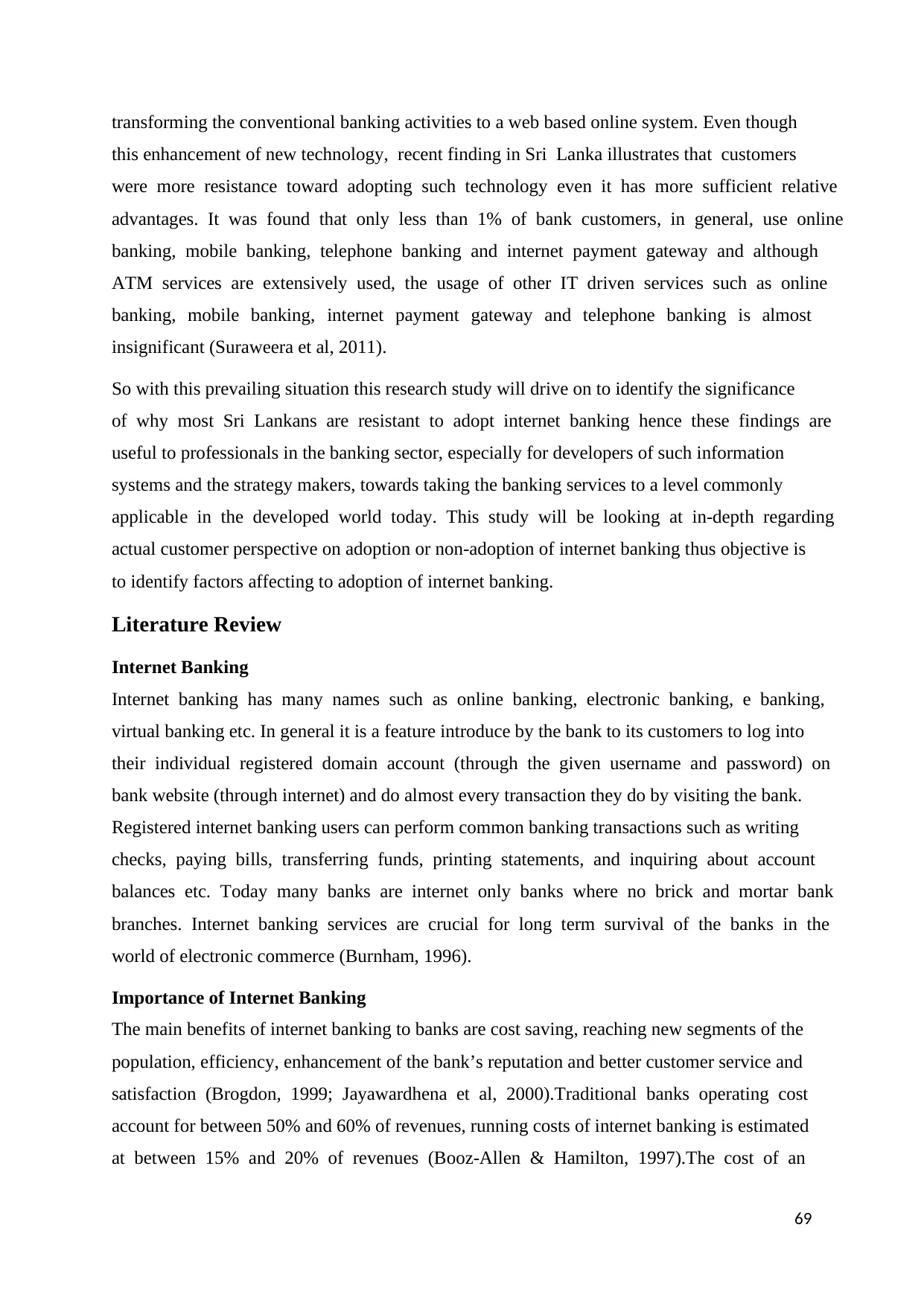
69
transforming the conventional banking activities to a web based online system. Even though
this enhancement of new technology, recent finding in Sri Lanka illustrates that customers
were more resistance toward adopting such technology even it has more sufficient relative
advantages. It was found that only less than 1% of bank customers, in general, use online
banking, mobile banking, telephone banking and internet payment gateway and although
ATM services are extensively used, the usage of other IT driven services such as online
banking, mobile banking, internet payment gateway and telephone banking is almost
insignificant (Suraweera et al, 2011).
So with this prevailing situation this research study will drive on to identify the significance
of why most Sri Lankans are resistant to adopt internet banking hence these findings are
useful to professionals in the banking sector, especially for developers of such information
systems and the strategy makers, towards taking the banking services to a level commonly
applicable in the developed world today. This study will be looking at in-depth regarding
actual customer perspective on adoption or non-adoption of internet banking thus objective is
to identify factors affecting to adoption of internet banking.
Literature Review
Internet Banking
Internet banking has many names such as online banking, electronic banking, e banking,
virtual banking etc. In general it is a feature introduce by the bank to its customers to log into
their individual registered domain account (through the given username and password) on
bank website (through internet) and do almost every transaction they do by visiting the bank.
Registered internet banking users can perform common banking transactions such as writing
checks, paying bills, transferring funds, printing statements, and inquiring about account
balances etc. Today many banks are internet only banks where no brick and mortar bank
branches. Internet banking services are crucial for long term survival of the banks in the
world of electronic commerce (Burnham, 1996).
Importance of Internet Banking
The main benefits of internet banking to banks are cost saving, reaching new segments of the
population, efficiency, enhancement of the bank’s reputation and better customer service and
satisfaction (Brogdon, 1999; Jayawardhena et al, 2000).Traditional banks operating cost
account for between 50% and 60% of revenues, running costs of internet banking is estimated
at between 15% and 20% of revenues (Booz-Allen & Hamilton, 1997).The cost of an
transforming the conventional banking activities to a web based online system. Even though
this enhancement of new technology, recent finding in Sri Lanka illustrates that customers
were more resistance toward adopting such technology even it has more sufficient relative
advantages. It was found that only less than 1% of bank customers, in general, use online
banking, mobile banking, telephone banking and internet payment gateway and although
ATM services are extensively used, the usage of other IT driven services such as online
banking, mobile banking, internet payment gateway and telephone banking is almost
insignificant (Suraweera et al, 2011).
So with this prevailing situation this research study will drive on to identify the significance
of why most Sri Lankans are resistant to adopt internet banking hence these findings are
useful to professionals in the banking sector, especially for developers of such information
systems and the strategy makers, towards taking the banking services to a level commonly
applicable in the developed world today. This study will be looking at in-depth regarding
actual customer perspective on adoption or non-adoption of internet banking thus objective is
to identify factors affecting to adoption of internet banking.
Literature Review
Internet Banking
Internet banking has many names such as online banking, electronic banking, e banking,
virtual banking etc. In general it is a feature introduce by the bank to its customers to log into
their individual registered domain account (through the given username and password) on
bank website (through internet) and do almost every transaction they do by visiting the bank.
Registered internet banking users can perform common banking transactions such as writing
checks, paying bills, transferring funds, printing statements, and inquiring about account
balances etc. Today many banks are internet only banks where no brick and mortar bank
branches. Internet banking services are crucial for long term survival of the banks in the
world of electronic commerce (Burnham, 1996).
Importance of Internet Banking
The main benefits of internet banking to banks are cost saving, reaching new segments of the
population, efficiency, enhancement of the bank’s reputation and better customer service and
satisfaction (Brogdon, 1999; Jayawardhena et al, 2000).Traditional banks operating cost
account for between 50% and 60% of revenues, running costs of internet banking is estimated
at between 15% and 20% of revenues (Booz-Allen & Hamilton, 1997).The cost of an
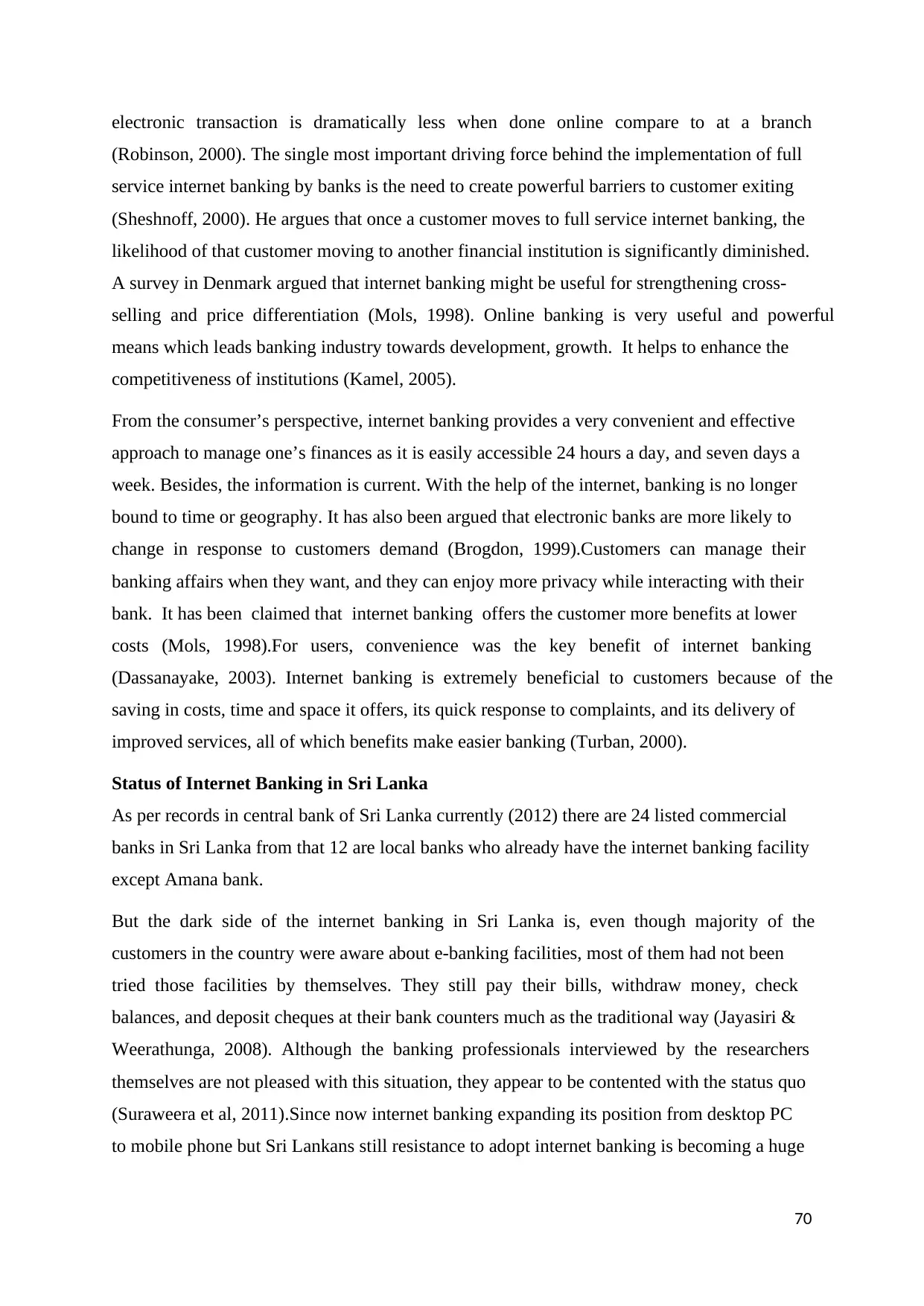
70
electronic transaction is dramatically less when done online compare to at a branch
(Robinson, 2000). The single most important driving force behind the implementation of full
service internet banking by banks is the need to create powerful barriers to customer exiting
(Sheshnoff, 2000). He argues that once a customer moves to full service internet banking, the
likelihood of that customer moving to another financial institution is significantly diminished.
A survey in Denmark argued that internet banking might be useful for strengthening cross-
selling and price differentiation (Mols, 1998). Online banking is very useful and powerful
means which leads banking industry towards development, growth. It helps to enhance the
competitiveness of institutions (Kamel, 2005).
From the consumer’s perspective, internet banking provides a very convenient and effective
approach to manage one’s finances as it is easily accessible 24 hours a day, and seven days a
week. Besides, the information is current. With the help of the internet, banking is no longer
bound to time or geography. It has also been argued that electronic banks are more likely to
change in response to customers demand (Brogdon, 1999).Customers can manage their
banking affairs when they want, and they can enjoy more privacy while interacting with their
bank. It has been claimed that internet banking offers the customer more benefits at lower
costs (Mols, 1998).For users, convenience was the key benefit of internet banking
(Dassanayake, 2003). Internet banking is extremely beneficial to customers because of the
saving in costs, time and space it offers, its quick response to complaints, and its delivery of
improved services, all of which benefits make easier banking (Turban, 2000).
Status of Internet Banking in Sri Lanka
As per records in central bank of Sri Lanka currently (2012) there are 24 listed commercial
banks in Sri Lanka from that 12 are local banks who already have the internet banking facility
except Amana bank.
But the dark side of the internet banking in Sri Lanka is, even though majority of the
customers in the country were aware about e-banking facilities, most of them had not been
tried those facilities by themselves. They still pay their bills, withdraw money, check
balances, and deposit cheques at their bank counters much as the traditional way (Jayasiri &
Weerathunga, 2008). Although the banking professionals interviewed by the researchers
themselves are not pleased with this situation, they appear to be contented with the status quo
(Suraweera et al, 2011).Since now internet banking expanding its position from desktop PC
to mobile phone but Sri Lankans still resistance to adopt internet banking is becoming a huge
electronic transaction is dramatically less when done online compare to at a branch
(Robinson, 2000). The single most important driving force behind the implementation of full
service internet banking by banks is the need to create powerful barriers to customer exiting
(Sheshnoff, 2000). He argues that once a customer moves to full service internet banking, the
likelihood of that customer moving to another financial institution is significantly diminished.
A survey in Denmark argued that internet banking might be useful for strengthening cross-
selling and price differentiation (Mols, 1998). Online banking is very useful and powerful
means which leads banking industry towards development, growth. It helps to enhance the
competitiveness of institutions (Kamel, 2005).
From the consumer’s perspective, internet banking provides a very convenient and effective
approach to manage one’s finances as it is easily accessible 24 hours a day, and seven days a
week. Besides, the information is current. With the help of the internet, banking is no longer
bound to time or geography. It has also been argued that electronic banks are more likely to
change in response to customers demand (Brogdon, 1999).Customers can manage their
banking affairs when they want, and they can enjoy more privacy while interacting with their
bank. It has been claimed that internet banking offers the customer more benefits at lower
costs (Mols, 1998).For users, convenience was the key benefit of internet banking
(Dassanayake, 2003). Internet banking is extremely beneficial to customers because of the
saving in costs, time and space it offers, its quick response to complaints, and its delivery of
improved services, all of which benefits make easier banking (Turban, 2000).
Status of Internet Banking in Sri Lanka
As per records in central bank of Sri Lanka currently (2012) there are 24 listed commercial
banks in Sri Lanka from that 12 are local banks who already have the internet banking facility
except Amana bank.
But the dark side of the internet banking in Sri Lanka is, even though majority of the
customers in the country were aware about e-banking facilities, most of them had not been
tried those facilities by themselves. They still pay their bills, withdraw money, check
balances, and deposit cheques at their bank counters much as the traditional way (Jayasiri &
Weerathunga, 2008). Although the banking professionals interviewed by the researchers
themselves are not pleased with this situation, they appear to be contented with the status quo
(Suraweera et al, 2011).Since now internet banking expanding its position from desktop PC
to mobile phone but Sri Lankans still resistance to adopt internet banking is becoming a huge
⊘ This is a preview!⊘
Do you want full access?
Subscribe today to unlock all pages.

Trusted by 1+ million students worldwide
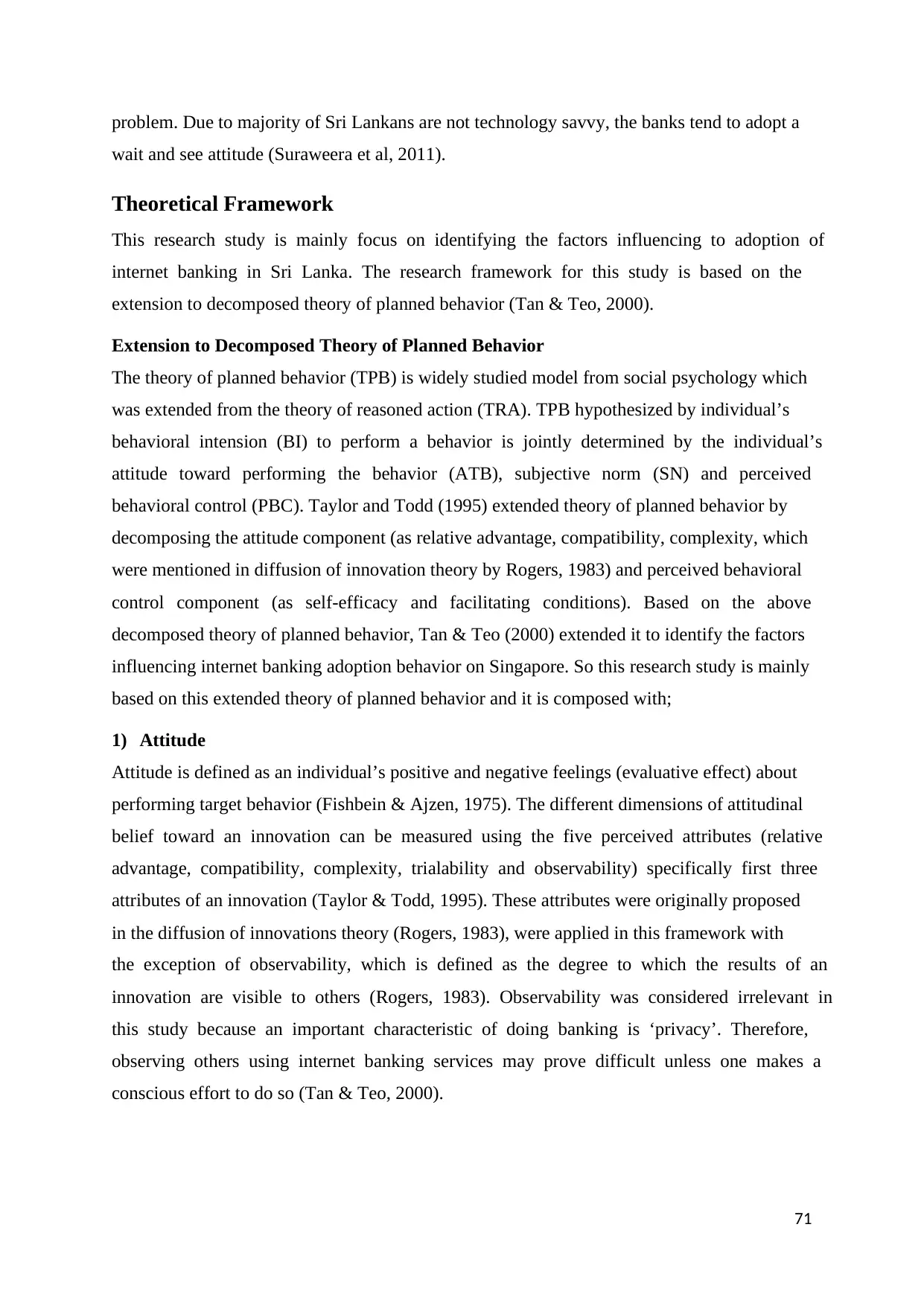
71
problem. Due to majority of Sri Lankans are not technology savvy, the banks tend to adopt a
wait and see attitude (Suraweera et al, 2011).
Theoretical Framework
This research study is mainly focus on identifying the factors influencing to adoption of
internet banking in Sri Lanka. The research framework for this study is based on the
extension to decomposed theory of planned behavior (Tan & Teo, 2000).
Extension to Decomposed Theory of Planned Behavior
The theory of planned behavior (TPB) is widely studied model from social psychology which
was extended from the theory of reasoned action (TRA). TPB hypothesized by individual’s
behavioral intension (BI) to perform a behavior is jointly determined by the individual’s
attitude toward performing the behavior (ATB), subjective norm (SN) and perceived
behavioral control (PBC). Taylor and Todd (1995) extended theory of planned behavior by
decomposing the attitude component (as relative advantage, compatibility, complexity, which
were mentioned in diffusion of innovation theory by Rogers, 1983) and perceived behavioral
control component (as self-efficacy and facilitating conditions). Based on the above
decomposed theory of planned behavior, Tan & Teo (2000) extended it to identify the factors
influencing internet banking adoption behavior on Singapore. So this research study is mainly
based on this extended theory of planned behavior and it is composed with;
1) Attitude
Attitude is defined as an individual’s positive and negative feelings (evaluative effect) about
performing target behavior (Fishbein & Ajzen, 1975). The different dimensions of attitudinal
belief toward an innovation can be measured using the five perceived attributes (relative
advantage, compatibility, complexity, trialability and observability) specifically first three
attributes of an innovation (Taylor & Todd, 1995). These attributes were originally proposed
in the diffusion of innovations theory (Rogers, 1983), were applied in this framework with
the exception of observability, which is defined as the degree to which the results of an
innovation are visible to others (Rogers, 1983). Observability was considered irrelevant in
this study because an important characteristic of doing banking is ‘privacy’. Therefore,
observing others using internet banking services may prove difficult unless one makes a
conscious effort to do so (Tan & Teo, 2000).
problem. Due to majority of Sri Lankans are not technology savvy, the banks tend to adopt a
wait and see attitude (Suraweera et al, 2011).
Theoretical Framework
This research study is mainly focus on identifying the factors influencing to adoption of
internet banking in Sri Lanka. The research framework for this study is based on the
extension to decomposed theory of planned behavior (Tan & Teo, 2000).
Extension to Decomposed Theory of Planned Behavior
The theory of planned behavior (TPB) is widely studied model from social psychology which
was extended from the theory of reasoned action (TRA). TPB hypothesized by individual’s
behavioral intension (BI) to perform a behavior is jointly determined by the individual’s
attitude toward performing the behavior (ATB), subjective norm (SN) and perceived
behavioral control (PBC). Taylor and Todd (1995) extended theory of planned behavior by
decomposing the attitude component (as relative advantage, compatibility, complexity, which
were mentioned in diffusion of innovation theory by Rogers, 1983) and perceived behavioral
control component (as self-efficacy and facilitating conditions). Based on the above
decomposed theory of planned behavior, Tan & Teo (2000) extended it to identify the factors
influencing internet banking adoption behavior on Singapore. So this research study is mainly
based on this extended theory of planned behavior and it is composed with;
1) Attitude
Attitude is defined as an individual’s positive and negative feelings (evaluative effect) about
performing target behavior (Fishbein & Ajzen, 1975). The different dimensions of attitudinal
belief toward an innovation can be measured using the five perceived attributes (relative
advantage, compatibility, complexity, trialability and observability) specifically first three
attributes of an innovation (Taylor & Todd, 1995). These attributes were originally proposed
in the diffusion of innovations theory (Rogers, 1983), were applied in this framework with
the exception of observability, which is defined as the degree to which the results of an
innovation are visible to others (Rogers, 1983). Observability was considered irrelevant in
this study because an important characteristic of doing banking is ‘privacy’. Therefore,
observing others using internet banking services may prove difficult unless one makes a
conscious effort to do so (Tan & Teo, 2000).
Paraphrase This Document
Need a fresh take? Get an instant paraphrase of this document with our AI Paraphraser
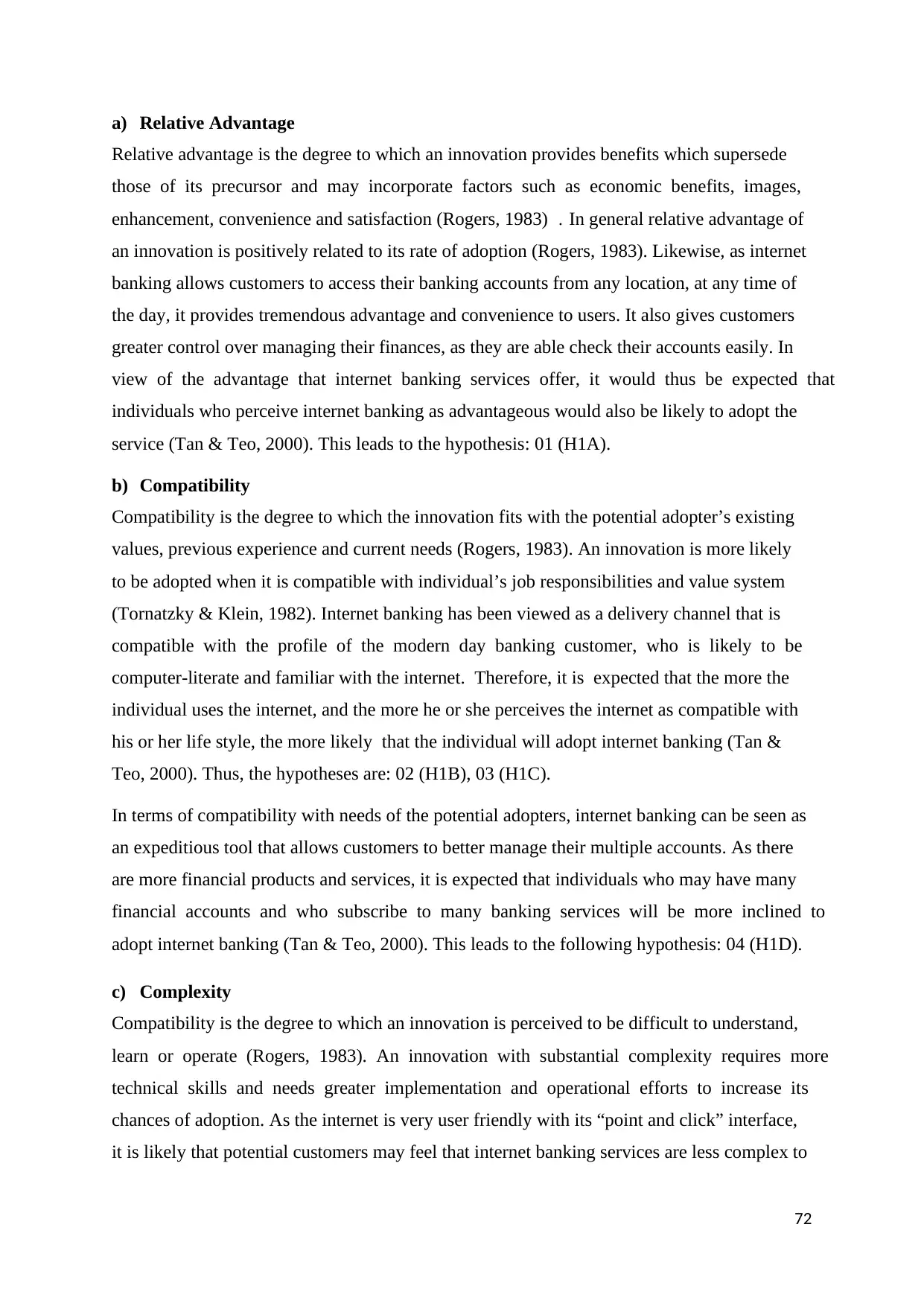
72
a) Relative Advantage
Relative advantage is the degree to which an innovation provides benefits which supersede
those of its precursor and may incorporate factors such as economic benefits, images,
enhancement, convenience and satisfaction (Rogers, 1983) . In general relative advantage of
an innovation is positively related to its rate of adoption (Rogers, 1983). Likewise, as internet
banking allows customers to access their banking accounts from any location, at any time of
the day, it provides tremendous advantage and convenience to users. It also gives customers
greater control over managing their finances, as they are able check their accounts easily. In
view of the advantage that internet banking services offer, it would thus be expected that
individuals who perceive internet banking as advantageous would also be likely to adopt the
service (Tan & Teo, 2000). This leads to the hypothesis: 01 (H1A).
b) Compatibility
Compatibility is the degree to which the innovation fits with the potential adopter’s existing
values, previous experience and current needs (Rogers, 1983). An innovation is more likely
to be adopted when it is compatible with individual’s job responsibilities and value system
(Tornatzky & Klein, 1982). Internet banking has been viewed as a delivery channel that is
compatible with the profile of the modern day banking customer, who is likely to be
computer-literate and familiar with the internet. Therefore, it is expected that the more the
individual uses the internet, and the more he or she perceives the internet as compatible with
his or her life style, the more likely that the individual will adopt internet banking (Tan &
Teo, 2000). Thus, the hypotheses are: 02 (H1B), 03 (H1C).
In terms of compatibility with needs of the potential adopters, internet banking can be seen as
an expeditious tool that allows customers to better manage their multiple accounts. As there
are more financial products and services, it is expected that individuals who may have many
financial accounts and who subscribe to many banking services will be more inclined to
adopt internet banking (Tan & Teo, 2000). This leads to the following hypothesis: 04 (H1D).
c) Complexity
Compatibility is the degree to which an innovation is perceived to be difficult to understand,
learn or operate (Rogers, 1983). An innovation with substantial complexity requires more
technical skills and needs greater implementation and operational efforts to increase its
chances of adoption. As the internet is very user friendly with its “point and click” interface,
it is likely that potential customers may feel that internet banking services are less complex to
a) Relative Advantage
Relative advantage is the degree to which an innovation provides benefits which supersede
those of its precursor and may incorporate factors such as economic benefits, images,
enhancement, convenience and satisfaction (Rogers, 1983) . In general relative advantage of
an innovation is positively related to its rate of adoption (Rogers, 1983). Likewise, as internet
banking allows customers to access their banking accounts from any location, at any time of
the day, it provides tremendous advantage and convenience to users. It also gives customers
greater control over managing their finances, as they are able check their accounts easily. In
view of the advantage that internet banking services offer, it would thus be expected that
individuals who perceive internet banking as advantageous would also be likely to adopt the
service (Tan & Teo, 2000). This leads to the hypothesis: 01 (H1A).
b) Compatibility
Compatibility is the degree to which the innovation fits with the potential adopter’s existing
values, previous experience and current needs (Rogers, 1983). An innovation is more likely
to be adopted when it is compatible with individual’s job responsibilities and value system
(Tornatzky & Klein, 1982). Internet banking has been viewed as a delivery channel that is
compatible with the profile of the modern day banking customer, who is likely to be
computer-literate and familiar with the internet. Therefore, it is expected that the more the
individual uses the internet, and the more he or she perceives the internet as compatible with
his or her life style, the more likely that the individual will adopt internet banking (Tan &
Teo, 2000). Thus, the hypotheses are: 02 (H1B), 03 (H1C).
In terms of compatibility with needs of the potential adopters, internet banking can be seen as
an expeditious tool that allows customers to better manage their multiple accounts. As there
are more financial products and services, it is expected that individuals who may have many
financial accounts and who subscribe to many banking services will be more inclined to
adopt internet banking (Tan & Teo, 2000). This leads to the following hypothesis: 04 (H1D).
c) Complexity
Compatibility is the degree to which an innovation is perceived to be difficult to understand,
learn or operate (Rogers, 1983). An innovation with substantial complexity requires more
technical skills and needs greater implementation and operational efforts to increase its
chances of adoption. As the internet is very user friendly with its “point and click” interface,
it is likely that potential customers may feel that internet banking services are less complex to
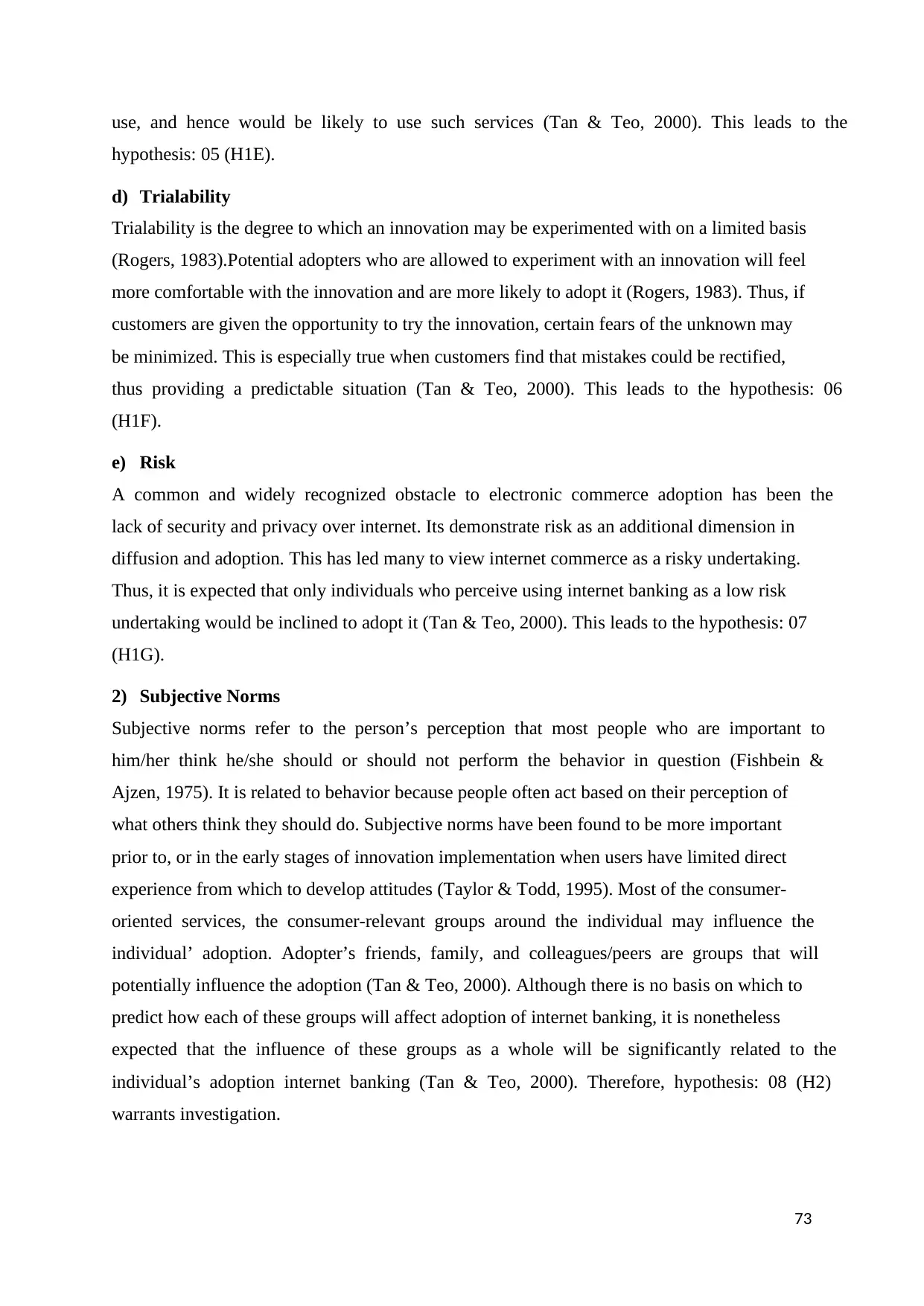
73
use, and hence would be likely to use such services (Tan & Teo, 2000). This leads to the
hypothesis: 05 (H1E).
d) Trialability
Trialability is the degree to which an innovation may be experimented with on a limited basis
(Rogers, 1983).Potential adopters who are allowed to experiment with an innovation will feel
more comfortable with the innovation and are more likely to adopt it (Rogers, 1983). Thus, if
customers are given the opportunity to try the innovation, certain fears of the unknown may
be minimized. This is especially true when customers find that mistakes could be rectified,
thus providing a predictable situation (Tan & Teo, 2000). This leads to the hypothesis: 06
(H1F).
e) Risk
A common and widely recognized obstacle to electronic commerce adoption has been the
lack of security and privacy over internet. Its demonstrate risk as an additional dimension in
diffusion and adoption. This has led many to view internet commerce as a risky undertaking.
Thus, it is expected that only individuals who perceive using internet banking as a low risk
undertaking would be inclined to adopt it (Tan & Teo, 2000). This leads to the hypothesis: 07
(H1G).
2) Subjective Norms
Subjective norms refer to the person’s perception that most people who are important to
him/her think he/she should or should not perform the behavior in question (Fishbein &
Ajzen, 1975). It is related to behavior because people often act based on their perception of
what others think they should do. Subjective norms have been found to be more important
prior to, or in the early stages of innovation implementation when users have limited direct
experience from which to develop attitudes (Taylor & Todd, 1995). Most of the consumer-
oriented services, the consumer-relevant groups around the individual may influence the
individual’ adoption. Adopter’s friends, family, and colleagues/peers are groups that will
potentially influence the adoption (Tan & Teo, 2000). Although there is no basis on which to
predict how each of these groups will affect adoption of internet banking, it is nonetheless
expected that the influence of these groups as a whole will be significantly related to the
individual’s adoption internet banking (Tan & Teo, 2000). Therefore, hypothesis: 08 (H2)
warrants investigation.
use, and hence would be likely to use such services (Tan & Teo, 2000). This leads to the
hypothesis: 05 (H1E).
d) Trialability
Trialability is the degree to which an innovation may be experimented with on a limited basis
(Rogers, 1983).Potential adopters who are allowed to experiment with an innovation will feel
more comfortable with the innovation and are more likely to adopt it (Rogers, 1983). Thus, if
customers are given the opportunity to try the innovation, certain fears of the unknown may
be minimized. This is especially true when customers find that mistakes could be rectified,
thus providing a predictable situation (Tan & Teo, 2000). This leads to the hypothesis: 06
(H1F).
e) Risk
A common and widely recognized obstacle to electronic commerce adoption has been the
lack of security and privacy over internet. Its demonstrate risk as an additional dimension in
diffusion and adoption. This has led many to view internet commerce as a risky undertaking.
Thus, it is expected that only individuals who perceive using internet banking as a low risk
undertaking would be inclined to adopt it (Tan & Teo, 2000). This leads to the hypothesis: 07
(H1G).
2) Subjective Norms
Subjective norms refer to the person’s perception that most people who are important to
him/her think he/she should or should not perform the behavior in question (Fishbein &
Ajzen, 1975). It is related to behavior because people often act based on their perception of
what others think they should do. Subjective norms have been found to be more important
prior to, or in the early stages of innovation implementation when users have limited direct
experience from which to develop attitudes (Taylor & Todd, 1995). Most of the consumer-
oriented services, the consumer-relevant groups around the individual may influence the
individual’ adoption. Adopter’s friends, family, and colleagues/peers are groups that will
potentially influence the adoption (Tan & Teo, 2000). Although there is no basis on which to
predict how each of these groups will affect adoption of internet banking, it is nonetheless
expected that the influence of these groups as a whole will be significantly related to the
individual’s adoption internet banking (Tan & Teo, 2000). Therefore, hypothesis: 08 (H2)
warrants investigation.
⊘ This is a preview!⊘
Do you want full access?
Subscribe today to unlock all pages.

Trusted by 1+ million students worldwide
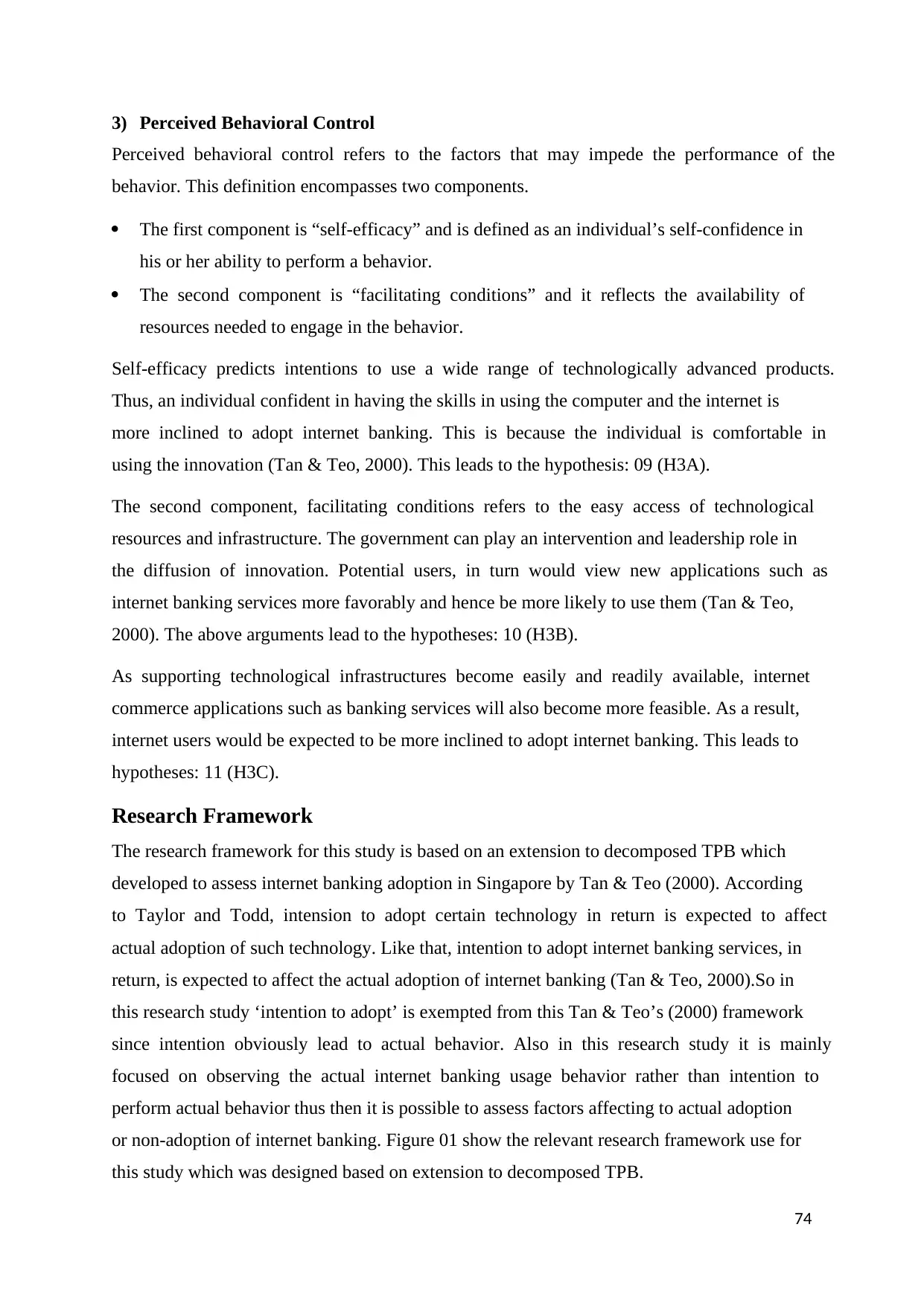
74
3) Perceived Behavioral Control
Perceived behavioral control refers to the factors that may impede the performance of the
behavior. This definition encompasses two components.
The first component is “self-efficacy” and is defined as an individual’s self-confidence in
his or her ability to perform a behavior.
The second component is “facilitating conditions” and it reflects the availability of
resources needed to engage in the behavior.
Self-efficacy predicts intentions to use a wide range of technologically advanced products.
Thus, an individual confident in having the skills in using the computer and the internet is
more inclined to adopt internet banking. This is because the individual is comfortable in
using the innovation (Tan & Teo, 2000). This leads to the hypothesis: 09 (H3A).
The second component, facilitating conditions refers to the easy access of technological
resources and infrastructure. The government can play an intervention and leadership role in
the diffusion of innovation. Potential users, in turn would view new applications such as
internet banking services more favorably and hence be more likely to use them (Tan & Teo,
2000). The above arguments lead to the hypotheses: 10 (H3B).
As supporting technological infrastructures become easily and readily available, internet
commerce applications such as banking services will also become more feasible. As a result,
internet users would be expected to be more inclined to adopt internet banking. This leads to
hypotheses: 11 (H3C).
Research Framework
The research framework for this study is based on an extension to decomposed TPB which
developed to assess internet banking adoption in Singapore by Tan & Teo (2000). According
to Taylor and Todd, intension to adopt certain technology in return is expected to affect
actual adoption of such technology. Like that, intention to adopt internet banking services, in
return, is expected to affect the actual adoption of internet banking (Tan & Teo, 2000).So in
this research study ‘intention to adopt’ is exempted from this Tan & Teo’s (2000) framework
since intention obviously lead to actual behavior. Also in this research study it is mainly
focused on observing the actual internet banking usage behavior rather than intention to
perform actual behavior thus then it is possible to assess factors affecting to actual adoption
or non-adoption of internet banking. Figure 01 show the relevant research framework use for
this study which was designed based on extension to decomposed TPB.
3) Perceived Behavioral Control
Perceived behavioral control refers to the factors that may impede the performance of the
behavior. This definition encompasses two components.
The first component is “self-efficacy” and is defined as an individual’s self-confidence in
his or her ability to perform a behavior.
The second component is “facilitating conditions” and it reflects the availability of
resources needed to engage in the behavior.
Self-efficacy predicts intentions to use a wide range of technologically advanced products.
Thus, an individual confident in having the skills in using the computer and the internet is
more inclined to adopt internet banking. This is because the individual is comfortable in
using the innovation (Tan & Teo, 2000). This leads to the hypothesis: 09 (H3A).
The second component, facilitating conditions refers to the easy access of technological
resources and infrastructure. The government can play an intervention and leadership role in
the diffusion of innovation. Potential users, in turn would view new applications such as
internet banking services more favorably and hence be more likely to use them (Tan & Teo,
2000). The above arguments lead to the hypotheses: 10 (H3B).
As supporting technological infrastructures become easily and readily available, internet
commerce applications such as banking services will also become more feasible. As a result,
internet users would be expected to be more inclined to adopt internet banking. This leads to
hypotheses: 11 (H3C).
Research Framework
The research framework for this study is based on an extension to decomposed TPB which
developed to assess internet banking adoption in Singapore by Tan & Teo (2000). According
to Taylor and Todd, intension to adopt certain technology in return is expected to affect
actual adoption of such technology. Like that, intention to adopt internet banking services, in
return, is expected to affect the actual adoption of internet banking (Tan & Teo, 2000).So in
this research study ‘intention to adopt’ is exempted from this Tan & Teo’s (2000) framework
since intention obviously lead to actual behavior. Also in this research study it is mainly
focused on observing the actual internet banking usage behavior rather than intention to
perform actual behavior thus then it is possible to assess factors affecting to actual adoption
or non-adoption of internet banking. Figure 01 show the relevant research framework use for
this study which was designed based on extension to decomposed TPB.
Paraphrase This Document
Need a fresh take? Get an instant paraphrase of this document with our AI Paraphraser
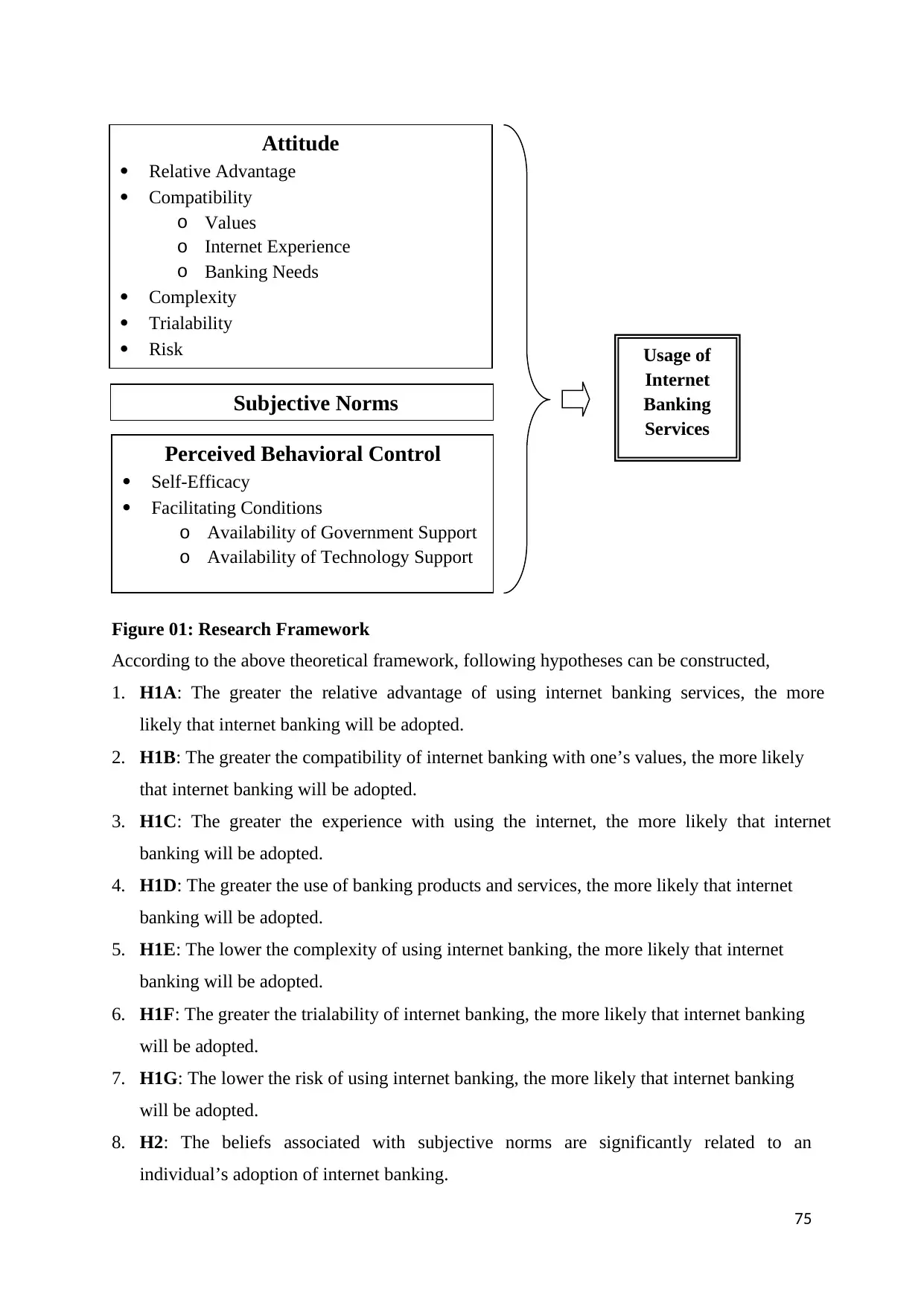
75
Figure
Figure 01: Research Framework
According to the above theoretical framework, following hypotheses can be constructed,
1. H1A: The greater the relative advantage of using internet banking services, the more
likely that internet banking will be adopted.
2. H1B: The greater the compatibility of internet banking with one’s values, the more likely
that internet banking will be adopted.
3. H1C: The greater the experience with using the internet, the more likely that internet
banking will be adopted.
4. H1D: The greater the use of banking products and services, the more likely that internet
banking will be adopted.
5. H1E: The lower the complexity of using internet banking, the more likely that internet
banking will be adopted.
6. H1F: The greater the trialability of internet banking, the more likely that internet banking
will be adopted.
7. H1G: The lower the risk of using internet banking, the more likely that internet banking
will be adopted.
8. H2: The beliefs associated with subjective norms are significantly related to an
individual’s adoption of internet banking.
Attitude
Relative Advantage
Compatibility
o Values
o Internet Experience
o Banking Needs
Complexity
Trialability
Risk Usage of
Internet
Banking
Services
Subjective Norms
Perceived Behavioral Control
Self-Efficacy
Facilitating Conditions
o Availability of Government Support
o Availability of Technology Support
Figure
Figure 01: Research Framework
According to the above theoretical framework, following hypotheses can be constructed,
1. H1A: The greater the relative advantage of using internet banking services, the more
likely that internet banking will be adopted.
2. H1B: The greater the compatibility of internet banking with one’s values, the more likely
that internet banking will be adopted.
3. H1C: The greater the experience with using the internet, the more likely that internet
banking will be adopted.
4. H1D: The greater the use of banking products and services, the more likely that internet
banking will be adopted.
5. H1E: The lower the complexity of using internet banking, the more likely that internet
banking will be adopted.
6. H1F: The greater the trialability of internet banking, the more likely that internet banking
will be adopted.
7. H1G: The lower the risk of using internet banking, the more likely that internet banking
will be adopted.
8. H2: The beliefs associated with subjective norms are significantly related to an
individual’s adoption of internet banking.
Attitude
Relative Advantage
Compatibility
o Values
o Internet Experience
o Banking Needs
Complexity
Trialability
Risk Usage of
Internet
Banking
Services
Subjective Norms
Perceived Behavioral Control
Self-Efficacy
Facilitating Conditions
o Availability of Government Support
o Availability of Technology Support
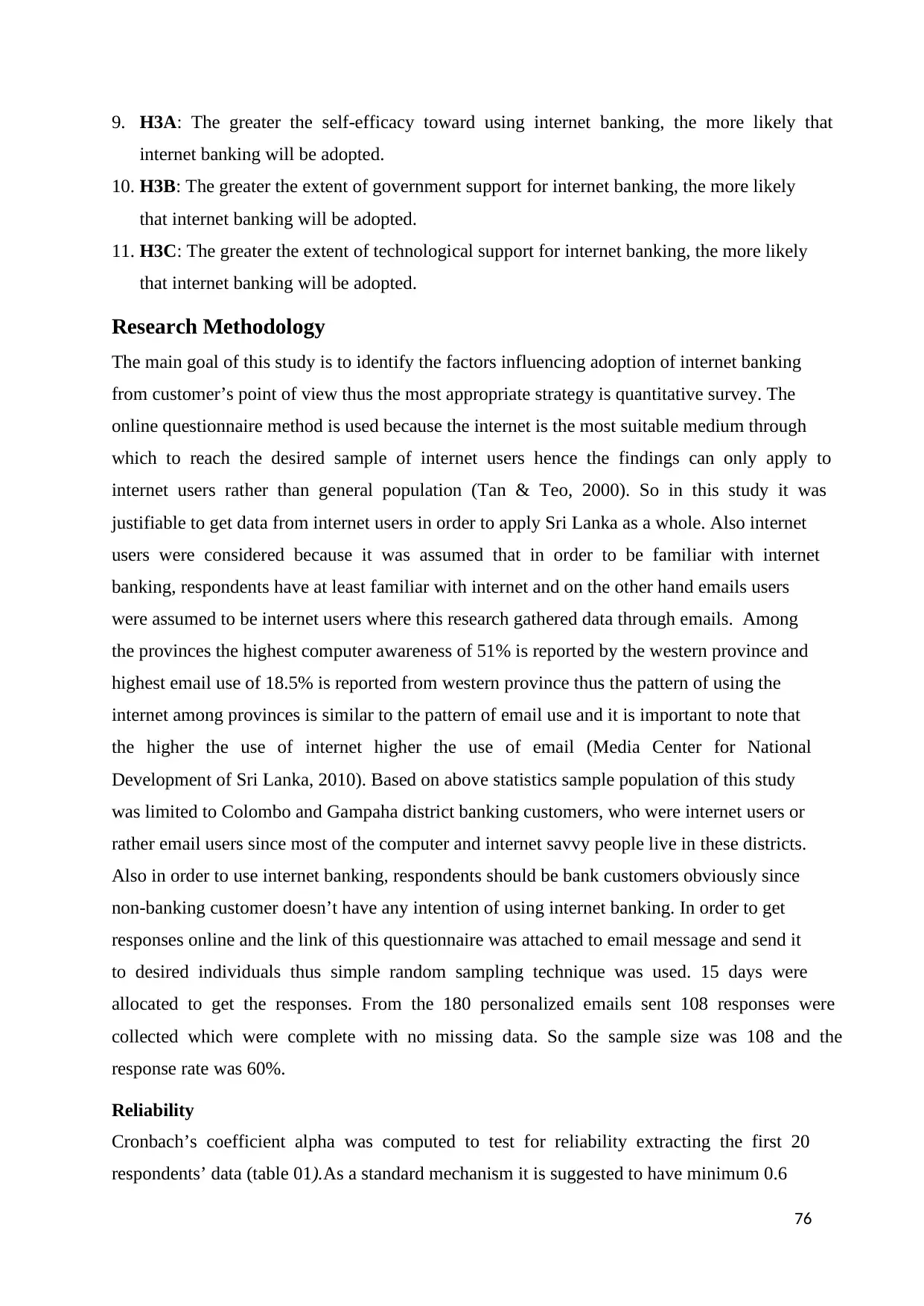
76
9. H3A: The greater the self-efficacy toward using internet banking, the more likely that
internet banking will be adopted.
10. H3B: The greater the extent of government support for internet banking, the more likely
that internet banking will be adopted.
11. H3C: The greater the extent of technological support for internet banking, the more likely
that internet banking will be adopted.
Research Methodology
The main goal of this study is to identify the factors influencing adoption of internet banking
from customer’s point of view thus the most appropriate strategy is quantitative survey. The
online questionnaire method is used because the internet is the most suitable medium through
which to reach the desired sample of internet users hence the findings can only apply to
internet users rather than general population (Tan & Teo, 2000). So in this study it was
justifiable to get data from internet users in order to apply Sri Lanka as a whole. Also internet
users were considered because it was assumed that in order to be familiar with internet
banking, respondents have at least familiar with internet and on the other hand emails users
were assumed to be internet users where this research gathered data through emails. Among
the provinces the highest computer awareness of 51% is reported by the western province and
highest email use of 18.5% is reported from western province thus the pattern of using the
internet among provinces is similar to the pattern of email use and it is important to note that
the higher the use of internet higher the use of email (Media Center for National
Development of Sri Lanka, 2010). Based on above statistics sample population of this study
was limited to Colombo and Gampaha district banking customers, who were internet users or
rather email users since most of the computer and internet savvy people live in these districts.
Also in order to use internet banking, respondents should be bank customers obviously since
non-banking customer doesn’t have any intention of using internet banking. In order to get
responses online and the link of this questionnaire was attached to email message and send it
to desired individuals thus simple random sampling technique was used. 15 days were
allocated to get the responses. From the 180 personalized emails sent 108 responses were
collected which were complete with no missing data. So the sample size was 108 and the
response rate was 60%.
Reliability
Cronbach’s coefficient alpha was computed to test for reliability extracting the first 20
respondents’ data (table 01).As a standard mechanism it is suggested to have minimum 0.6
9. H3A: The greater the self-efficacy toward using internet banking, the more likely that
internet banking will be adopted.
10. H3B: The greater the extent of government support for internet banking, the more likely
that internet banking will be adopted.
11. H3C: The greater the extent of technological support for internet banking, the more likely
that internet banking will be adopted.
Research Methodology
The main goal of this study is to identify the factors influencing adoption of internet banking
from customer’s point of view thus the most appropriate strategy is quantitative survey. The
online questionnaire method is used because the internet is the most suitable medium through
which to reach the desired sample of internet users hence the findings can only apply to
internet users rather than general population (Tan & Teo, 2000). So in this study it was
justifiable to get data from internet users in order to apply Sri Lanka as a whole. Also internet
users were considered because it was assumed that in order to be familiar with internet
banking, respondents have at least familiar with internet and on the other hand emails users
were assumed to be internet users where this research gathered data through emails. Among
the provinces the highest computer awareness of 51% is reported by the western province and
highest email use of 18.5% is reported from western province thus the pattern of using the
internet among provinces is similar to the pattern of email use and it is important to note that
the higher the use of internet higher the use of email (Media Center for National
Development of Sri Lanka, 2010). Based on above statistics sample population of this study
was limited to Colombo and Gampaha district banking customers, who were internet users or
rather email users since most of the computer and internet savvy people live in these districts.
Also in order to use internet banking, respondents should be bank customers obviously since
non-banking customer doesn’t have any intention of using internet banking. In order to get
responses online and the link of this questionnaire was attached to email message and send it
to desired individuals thus simple random sampling technique was used. 15 days were
allocated to get the responses. From the 180 personalized emails sent 108 responses were
collected which were complete with no missing data. So the sample size was 108 and the
response rate was 60%.
Reliability
Cronbach’s coefficient alpha was computed to test for reliability extracting the first 20
respondents’ data (table 01).As a standard mechanism it is suggested to have minimum 0.6
⊘ This is a preview!⊘
Do you want full access?
Subscribe today to unlock all pages.

Trusted by 1+ million students worldwide
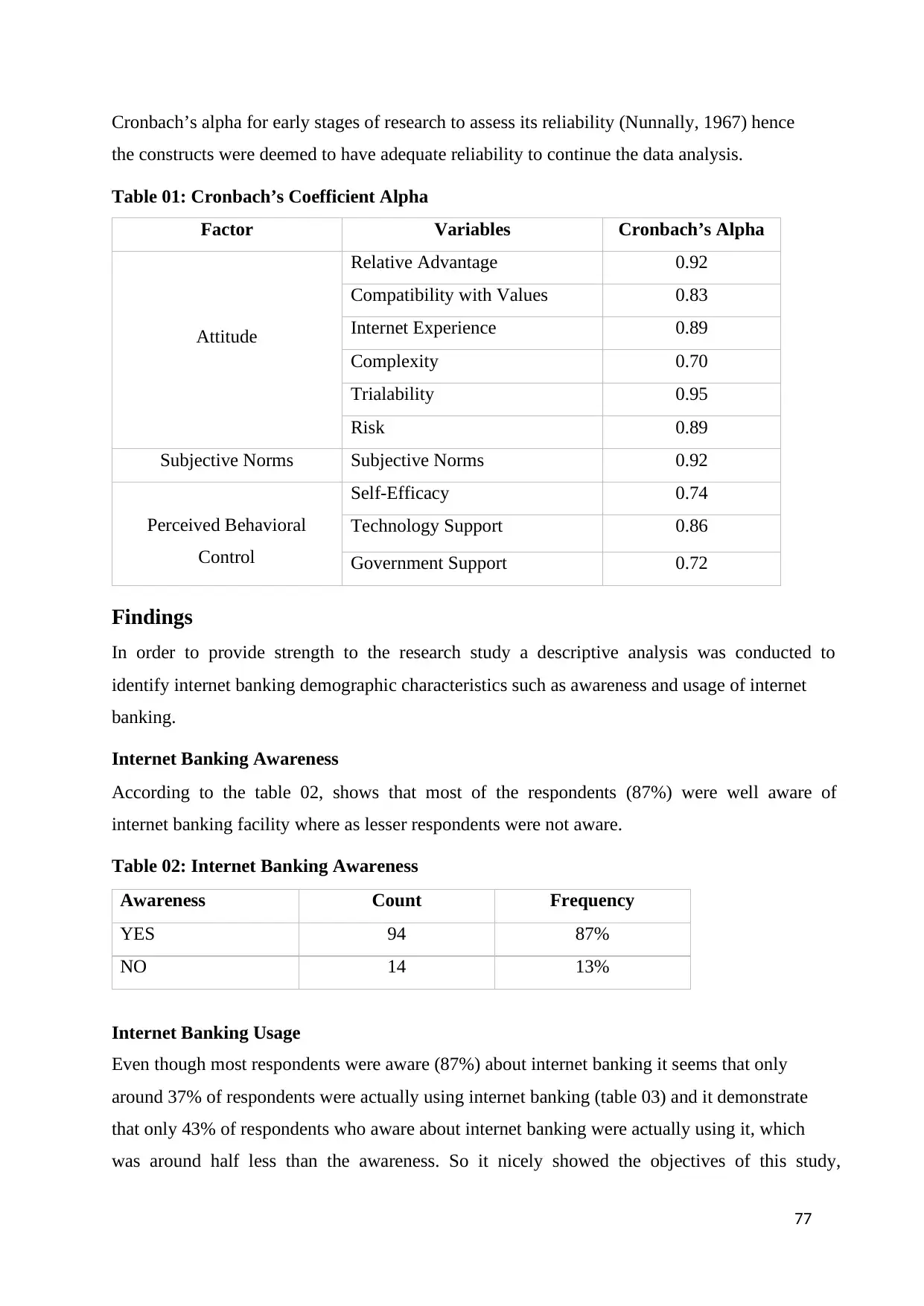
77
Cronbach’s alpha for early stages of research to assess its reliability (Nunnally, 1967) hence
the constructs were deemed to have adequate reliability to continue the data analysis.
Table 01: Cronbach’s Coefficient Alpha
Factor Variables Cronbach’s Alpha
Attitude
Relative Advantage 0.92
Compatibility with Values 0.83
Internet Experience 0.89
Complexity 0.70
Trialability 0.95
Risk 0.89
Subjective Norms Subjective Norms 0.92
Perceived Behavioral
Control
Self-Efficacy 0.74
Technology Support 0.86
Government Support 0.72
Findings
In order to provide strength to the research study a descriptive analysis was conducted to
identify internet banking demographic characteristics such as awareness and usage of internet
banking.
Internet Banking Awareness
According to the table 02, shows that most of the respondents (87%) were well aware of
internet banking facility where as lesser respondents were not aware.
Table 02: Internet Banking Awareness
Awareness Count Frequency
YES 94 87%
NO 14 13%
Internet Banking Usage
Even though most respondents were aware (87%) about internet banking it seems that only
around 37% of respondents were actually using internet banking (table 03) and it demonstrate
that only 43% of respondents who aware about internet banking were actually using it, which
was around half less than the awareness. So it nicely showed the objectives of this study,
Cronbach’s alpha for early stages of research to assess its reliability (Nunnally, 1967) hence
the constructs were deemed to have adequate reliability to continue the data analysis.
Table 01: Cronbach’s Coefficient Alpha
Factor Variables Cronbach’s Alpha
Attitude
Relative Advantage 0.92
Compatibility with Values 0.83
Internet Experience 0.89
Complexity 0.70
Trialability 0.95
Risk 0.89
Subjective Norms Subjective Norms 0.92
Perceived Behavioral
Control
Self-Efficacy 0.74
Technology Support 0.86
Government Support 0.72
Findings
In order to provide strength to the research study a descriptive analysis was conducted to
identify internet banking demographic characteristics such as awareness and usage of internet
banking.
Internet Banking Awareness
According to the table 02, shows that most of the respondents (87%) were well aware of
internet banking facility where as lesser respondents were not aware.
Table 02: Internet Banking Awareness
Awareness Count Frequency
YES 94 87%
NO 14 13%
Internet Banking Usage
Even though most respondents were aware (87%) about internet banking it seems that only
around 37% of respondents were actually using internet banking (table 03) and it demonstrate
that only 43% of respondents who aware about internet banking were actually using it, which
was around half less than the awareness. So it nicely showed the objectives of this study,
Paraphrase This Document
Need a fresh take? Get an instant paraphrase of this document with our AI Paraphraser
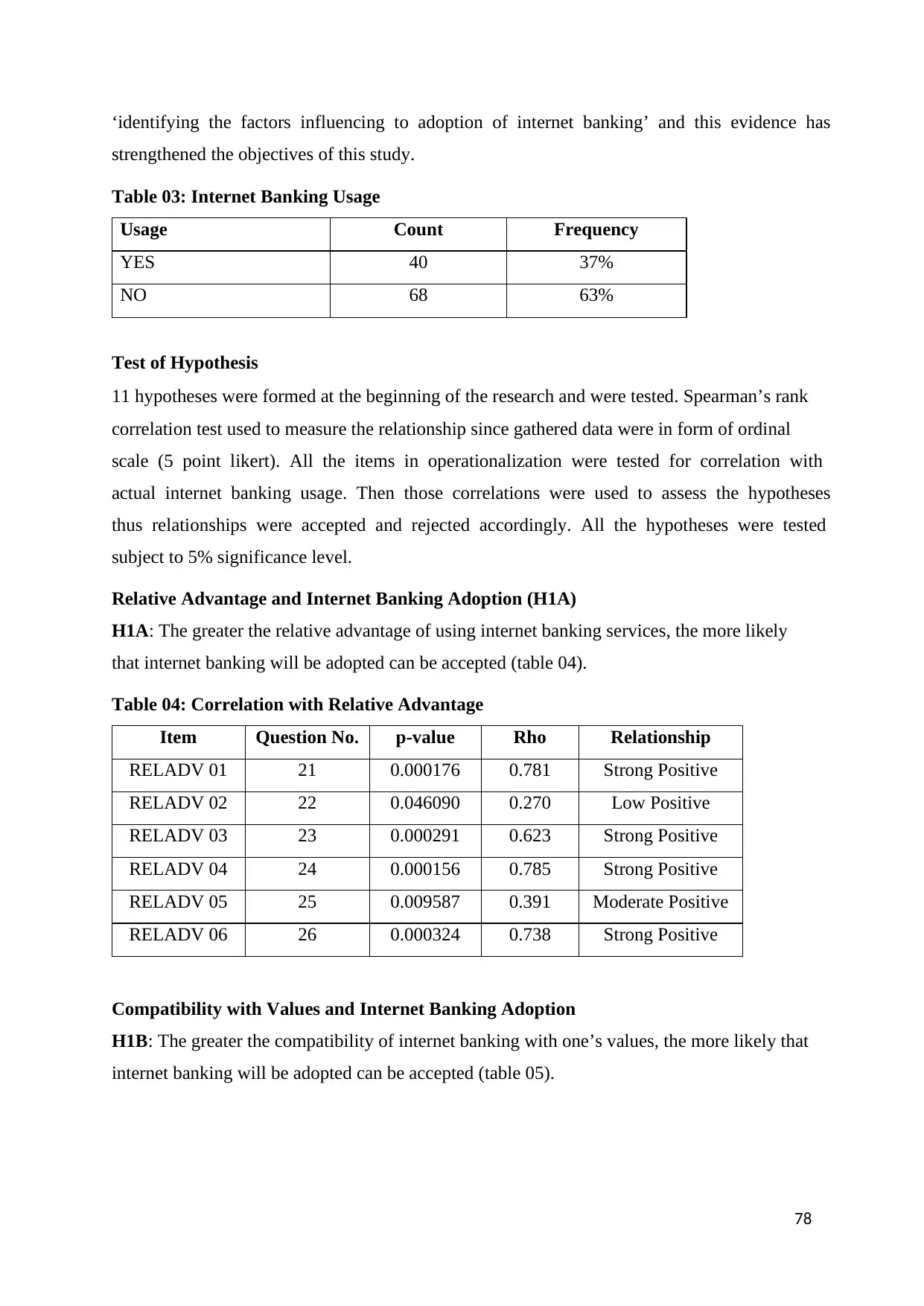
78
‘identifying the factors influencing to adoption of internet banking’ and this evidence has
strengthened the objectives of this study.
Table 03: Internet Banking Usage
Usage Count Frequency
YES 40 37%
NO 68 63%
Test of Hypothesis
11 hypotheses were formed at the beginning of the research and were tested. Spearman’s rank
correlation test used to measure the relationship since gathered data were in form of ordinal
scale (5 point likert). All the items in operationalization were tested for correlation with
actual internet banking usage. Then those correlations were used to assess the hypotheses
thus relationships were accepted and rejected accordingly. All the hypotheses were tested
subject to 5% significance level.
Relative Advantage and Internet Banking Adoption (H1A)
H1A: The greater the relative advantage of using internet banking services, the more likely
that internet banking will be adopted can be accepted (table 04).
Table 04: Correlation with Relative Advantage
Item Question No. p-value Rho Relationship
RELADV 01 21 0.000176 0.781 Strong Positive
RELADV 02 22 0.046090 0.270 Low Positive
RELADV 03 23 0.000291 0.623 Strong Positive
RELADV 04 24 0.000156 0.785 Strong Positive
RELADV 05 25 0.009587 0.391 Moderate Positive
RELADV 06 26 0.000324 0.738 Strong Positive
Compatibility with Values and Internet Banking Adoption
H1B: The greater the compatibility of internet banking with one’s values, the more likely that
internet banking will be adopted can be accepted (table 05).
‘identifying the factors influencing to adoption of internet banking’ and this evidence has
strengthened the objectives of this study.
Table 03: Internet Banking Usage
Usage Count Frequency
YES 40 37%
NO 68 63%
Test of Hypothesis
11 hypotheses were formed at the beginning of the research and were tested. Spearman’s rank
correlation test used to measure the relationship since gathered data were in form of ordinal
scale (5 point likert). All the items in operationalization were tested for correlation with
actual internet banking usage. Then those correlations were used to assess the hypotheses
thus relationships were accepted and rejected accordingly. All the hypotheses were tested
subject to 5% significance level.
Relative Advantage and Internet Banking Adoption (H1A)
H1A: The greater the relative advantage of using internet banking services, the more likely
that internet banking will be adopted can be accepted (table 04).
Table 04: Correlation with Relative Advantage
Item Question No. p-value Rho Relationship
RELADV 01 21 0.000176 0.781 Strong Positive
RELADV 02 22 0.046090 0.270 Low Positive
RELADV 03 23 0.000291 0.623 Strong Positive
RELADV 04 24 0.000156 0.785 Strong Positive
RELADV 05 25 0.009587 0.391 Moderate Positive
RELADV 06 26 0.000324 0.738 Strong Positive
Compatibility with Values and Internet Banking Adoption
H1B: The greater the compatibility of internet banking with one’s values, the more likely that
internet banking will be adopted can be accepted (table 05).
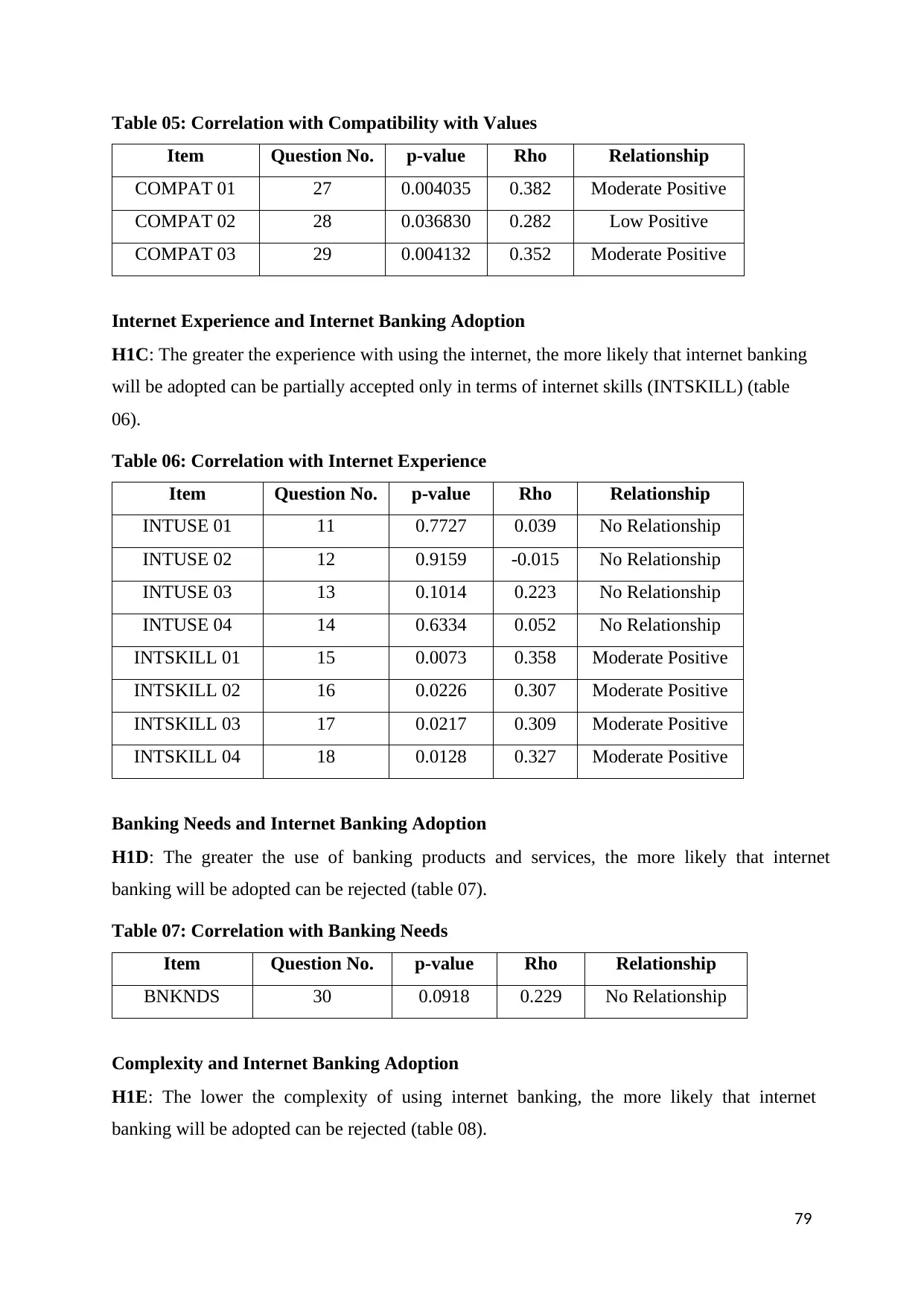
79
Table 05: Correlation with Compatibility with Values
Item Question No. p-value Rho Relationship
COMPAT 01 27 0.004035 0.382 Moderate Positive
COMPAT 02 28 0.036830 0.282 Low Positive
COMPAT 03 29 0.004132 0.352 Moderate Positive
Internet Experience and Internet Banking Adoption
H1C: The greater the experience with using the internet, the more likely that internet banking
will be adopted can be partially accepted only in terms of internet skills (INTSKILL) (table
06).
Table 06: Correlation with Internet Experience
Item Question No. p-value Rho Relationship
INTUSE 01 11 0.7727 0.039 No Relationship
INTUSE 02 12 0.9159 -0.015 No Relationship
INTUSE 03 13 0.1014 0.223 No Relationship
INTUSE 04 14 0.6334 0.052 No Relationship
INTSKILL 01 15 0.0073 0.358 Moderate Positive
INTSKILL 02 16 0.0226 0.307 Moderate Positive
INTSKILL 03 17 0.0217 0.309 Moderate Positive
INTSKILL 04 18 0.0128 0.327 Moderate Positive
Banking Needs and Internet Banking Adoption
H1D: The greater the use of banking products and services, the more likely that internet
banking will be adopted can be rejected (table 07).
Table 07: Correlation with Banking Needs
Item Question No. p-value Rho Relationship
BNKNDS 30 0.0918 0.229 No Relationship
Complexity and Internet Banking Adoption
H1E: The lower the complexity of using internet banking, the more likely that internet
banking will be adopted can be rejected (table 08).
Table 05: Correlation with Compatibility with Values
Item Question No. p-value Rho Relationship
COMPAT 01 27 0.004035 0.382 Moderate Positive
COMPAT 02 28 0.036830 0.282 Low Positive
COMPAT 03 29 0.004132 0.352 Moderate Positive
Internet Experience and Internet Banking Adoption
H1C: The greater the experience with using the internet, the more likely that internet banking
will be adopted can be partially accepted only in terms of internet skills (INTSKILL) (table
06).
Table 06: Correlation with Internet Experience
Item Question No. p-value Rho Relationship
INTUSE 01 11 0.7727 0.039 No Relationship
INTUSE 02 12 0.9159 -0.015 No Relationship
INTUSE 03 13 0.1014 0.223 No Relationship
INTUSE 04 14 0.6334 0.052 No Relationship
INTSKILL 01 15 0.0073 0.358 Moderate Positive
INTSKILL 02 16 0.0226 0.307 Moderate Positive
INTSKILL 03 17 0.0217 0.309 Moderate Positive
INTSKILL 04 18 0.0128 0.327 Moderate Positive
Banking Needs and Internet Banking Adoption
H1D: The greater the use of banking products and services, the more likely that internet
banking will be adopted can be rejected (table 07).
Table 07: Correlation with Banking Needs
Item Question No. p-value Rho Relationship
BNKNDS 30 0.0918 0.229 No Relationship
Complexity and Internet Banking Adoption
H1E: The lower the complexity of using internet banking, the more likely that internet
banking will be adopted can be rejected (table 08).
⊘ This is a preview!⊘
Do you want full access?
Subscribe today to unlock all pages.

Trusted by 1+ million students worldwide
1 out of 20
Related Documents
Your All-in-One AI-Powered Toolkit for Academic Success.
+13062052269
info@desklib.com
Available 24*7 on WhatsApp / Email
![[object Object]](/_next/static/media/star-bottom.7253800d.svg)
Unlock your academic potential
Copyright © 2020–2025 A2Z Services. All Rights Reserved. Developed and managed by ZUCOL.





